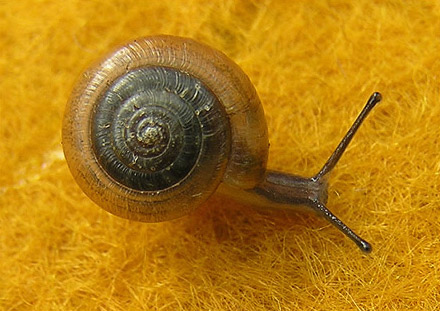Pennsylvania Land Snails

Photo(s): Bill Frank
Ventridens demissus (A. Binney, 1843)
Common name: Perforate dome
Family Gastrodontidae
Order Stylommatophora
There are several dome snail species in Pennsylvania, their shell shapes reminiscent of famous Russian domed churches. The perforate dome is a relatively “depressed” variation on this theme, being wider than tall.
Adult shells of the perforate dome are 7.5 to 10mm in diameter, 5 to 7mm tall, and a glossy yellow-brown color (Pilsbry, 1946). They are closely whorled, having 6 to 7 revolutions. Adult shells have a thick white lining on the inside base of the aperture, and the umbilicus is, of course, perforate (narrowly open).
While the perforate dome may be found in a variety of habitats, it is among those species that appear to be successful colonists of river floodplains, where it can reach high densities (dozens per square meter, Hotopp, pers. obs.). Otherwise, this habitat often has reduced land snail diversity, presumably due to the impacts of high water.
The perforate dome is distinguished from its close congener the globose dome (Ventridens ligera) by its smaller size and flatter shell. However, for this character there appears to be some overlap between the species. The shell of the perforate dome goes through a transformation as it grows – very young shells may have basal lamina not see in mature shells (Pilsbry, 1946). While Ventridens ligera lacks laminae at all growth stages, the small adults of another similar but smaller species, Ventridens suppressus, also have laminae, which can lead to some confusion.
The perforate dome is reported from southwestern Pennsylvania (e.g. Hubricht, 1985), and Warren County, but is not widespread in the Keystone State. In addition there are some questions as to its proper identification, and therefore its distribution, in Pennsylvania and elsewhere.
Lending weight to questions about the identification of this snail is its unusual global distribution. The perforate dome is reported in the highlands to the south of Pennsylvania, but then south to the lowlands of coastal Louisiana, Texas and western Florida, while not appearing on the East Coast.
 Development of this site was supported by the generous contributions of Pennsylvanians to the Wild Resource Conservation Fund.
Development of this site was supported by the generous contributions of Pennsylvanians to the Wild Resource Conservation Fund.
